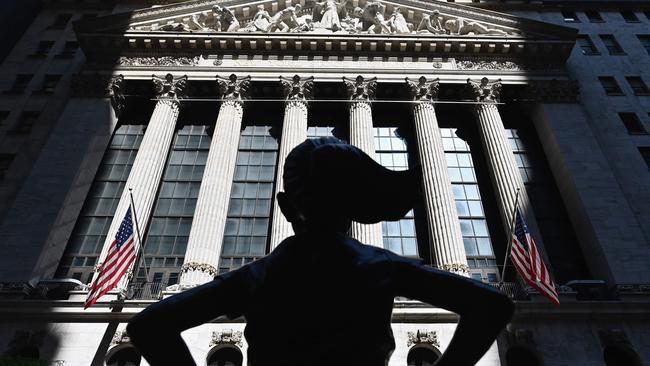Magnificent Seven heaven: Tech stocks drive S&P 500 to record
Central banks pushing back on the timing of rate cuts expected by markets have not stopped the rise in stocks, as tech giants keep pushing the S&P 500 to record highs.

Business
Don't miss out on the headlines from Business. Followed categories will be added to My News.
Central banks pushing back on the timing of rate cuts expected by markets have not stopped the rise in stocks, as tech giants keep pushing the S&P 500 to record highs.
With Microsoft, Nvidia and Meta Platforms up about 2-3 per cent on Wednesday, the S&P 500 rose 0.8 per cent to a record high close of 4995.06 points, even with Snap down 35 per cent on disappointing results, and lingering jitters about regional bank commercial real estate exposures.
The S&P 500 has risen to the upper end of strategists’ forecasts for the year-end level of the benchmark, which range between 4200 and 5400 after a flurry of upgrades in recent weeks.
The bond market rally that drove the December quarter surge in developed markets stocks may have stalled, amid less dovish central bank rhetoric and increasingly stronger than expected US economic data, and even some positive surprises from eurozone data.
Comprehensively stronger than expected US non-farm payrolls data and Federal Reserve chairman Jerome Powell’s pushback on early US rate cuts in a 60 Minutes interview this week pushed the US 10-year bond yield up 28 basis points in two days to 4.16 per cent. It was its biggest two-day rise in 20 months.
But it hasn’t mattered for US stocks, and the Australian market is being pulled higher as well.
“Even as US yields backed up a touch, notably the S&P 500 approached the 5000 mark for the first time, hinting at mega-cap tech’s decoupling from bond yields but supported by an upbeat macro story, where the economy continues to operate at an above-trend pace with no material signs of falling below trend in the near term,” SPI Asset Management managing partner Stephen Innes said.
“Higher rates don’t appear to burden consumers or corporations significantly, enabling the Fed to wait longer to ensure inflation is controlled without disrupting the stockmarket’s momentum amid robust US growth dynamic.”
As well as a run of stronger than expected US economic data combined with lessening inflationary pressures for the most part, US stocks have also been helped by earnings reports.
Two-thirds of the way through US earnings season, companies have on average beaten their quarterly earnings estimates by 6 per cent, versus a norm of 3 per cent, according to BofA.

Overall, 70 per cent of S&P 500 companies have exceeded consensus estimates versus an historical norm of 63 per cent, mainly due to stronger than expected margins, with quarterly earnings on track for a modest rise of about 2 per cent on-year.
Bloomberg’s index of the Magnificent Seven tech stocks – Amazon, Apple, Alphabet, Nvidia, Meta Platforms, Microsoft and Tesla – that account for about 30 per cent of the S&P 500’s value were up 6.8 per cent in the month to date. That’s more than twice a 3.1 per cent rise in the benchmark.
Last year the Magnificent Seven stocks rose 75 per cent, versus 24 per cent for the S&P 500.
A day of reckoning for the AI boom may eventually come as it did for the dotcom bubble in 2000.
But for the time being most active fund managers are just trying not to get their faces ripped off by being underweight too many of the US tech giants that are driving the market higher.
JPMorgan noted that the largest 10 US stocks continued to increase at the expense of the rest of the market, causing active managers to deliver one of their worst relative performances on record last year given the narrow opportunity set of winners tilted towards mega-cap companies.
The US bank argues that the exceptionally strong payroll report “poses a challenge for the goldilocks/soft landing view” as it challenges the market’s assumptions of aggressive rate cuts.
US rate cut pricing has fallen from the six cuts this year that were expected earlier this month. A rate cut in March, priced as a near certainty at the start of the year, has come in to 18 per cent. A total of 120 basis points of cuts was priced in for the year, versus close to 150 basis points that was priced in early January, though it remains on the high side of the Fed’s “dot plot” guidance of 75bps.
“It’s becoming increasingly evident that equities are unfazed and indifferent to the Federal Reserve’s less dovish stance, which suggests that unless there is a substantial deterioration in the labour market, the central bank’s baseline expectation for 2024 includes three rate cuts,” Mr Innes said.
As the year began after a risk-on rally in November and December primarily driven by increasing bets on rate cuts and declining bond yields, there was significant speculation about whether stocks could maintain their strength if market expectations for Fed easing diminished.
“Market pricing still suggests more easing compared to the last dot plot released by the Federal Reserve, but when you delve into what drives that pricing – the array of potential macro-policy scenarios and the probabilities traders attach to them – it’s reasonable to argue that the rates market’s ‘base case’ now aligns closer with the Fed’s projections,” Mr Innes said.
The “extra” rate cutting beyond 75bps priced by the market reflects traders’ assessment of the Fed’s willingness to act decisively in response to devolving economic conditions.
It may also reflect the probabilities traders assign to risks, including geopolitics, economic shocks and other unforeseen developments that could affect the outlook and necessitate policy adjustments by the Fed.
“Equities seem to have become indifferent to the movements in rates and bonds, particularly after the Fed removed its tightening bias,” Mr Innes said.
He said every corner of Wall Street had revised its US growth forecast for this year upward.
“This optimistic backdrop has also supported earnings growth, which has been crucial for equities, particularly amid pressure from higher interest rates,” he said. “As we progress through the fourth-quarter reporting period, S&P 500 operating earnings growth is much better than expected and has effectively diminished the influence of bearish sentiment in the market.”
More Coverage
Originally published as Magnificent Seven heaven: Tech stocks drive S&P 500 to record





